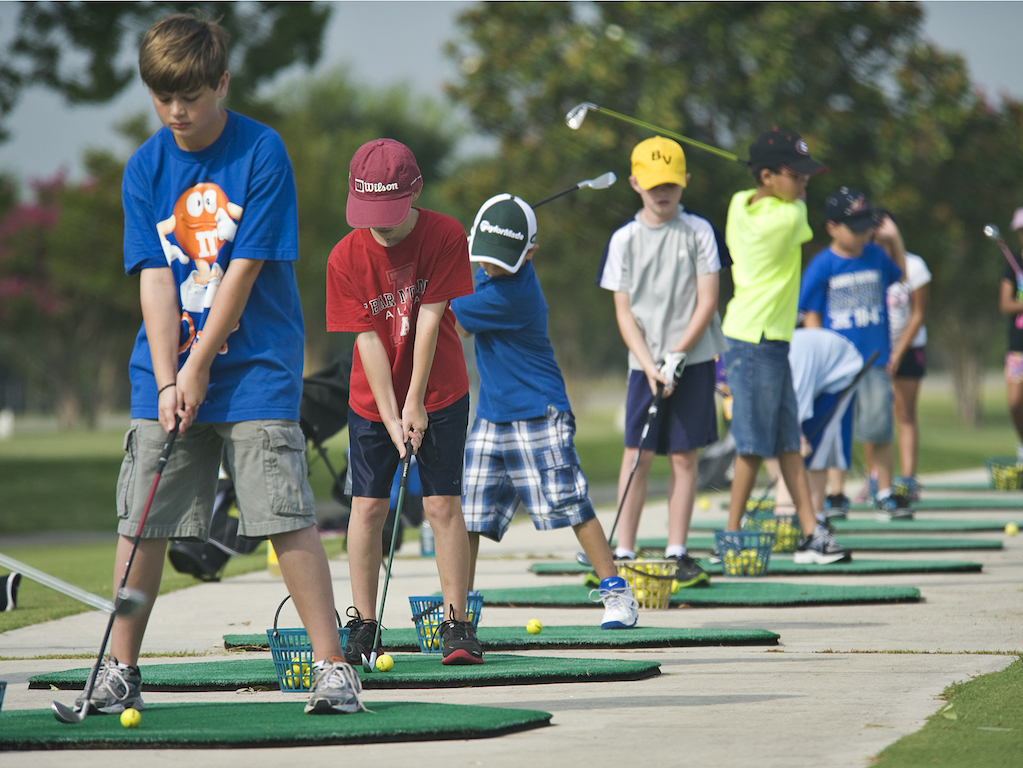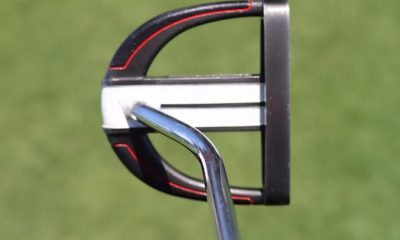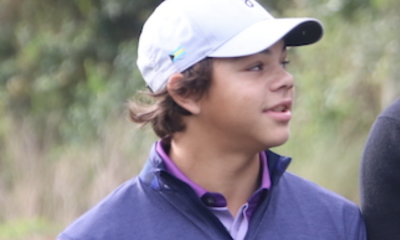Opinion & Analysis
Youth player development: The lifeblood of the golf industry

When people hear the phrase “junior golf,” they tend to think of things like group clinics, summer camps, or perhaps even an annual father-son event. These types of things come to mind: the images of kids strung across a driving range, whacking away and free-wheeling at golf balls, with little thought given to aim or technique, is the likely vision one sees. For some, the idea of a glorified babysitting service, with golf clubs, may come to mind…something offered at the club so mom and dad can enjoy a beverage or two.
In my mind, these stereotypical ideas of what “junior golf” is are very sad ways of characterizing programming for our youth. What’s even worse, is the fact that many golf professionals buy into these stereotypes and provide “junior golf” programming in such a manor.
From this point on, for the sake of this discussion, let’s stop using the term “junior golf.” That phrase alone may be so ingrained in the minds of many, that images as what was mentioned above can’t help but come to mind. I think the phrase, “youth player development” sounds much, much better. In the big picture, that is what we, the PGA Golf Professionals, as keepers of the game, should be doing…developing players. In this case, the development of players has a focus on the youth within our communities.
The impact that “youth player development” has on our game overall cannot be understated. It is the gateway to the long-term health of the golf industry. It has been proven that a positive, fun and productive introduction to golf leads to lifelong golfers. For the gatekeepers of the game, the PGA Professionals, that is the mission. We must continue to develop players in order for courses to continue to operate. It’s a very simple fact of economics, you must create a demand for a product or service in order for your business to survive.
So, if a structured, positive and fun introduction of golf to kids is almost proven to create lifelong golfers, why is it sadly still seen as a “nice to do” or “feel good” thing by many? The answer, simply, is that many owners and operators get stuck in the instant…the now…and the quick buck. The idea of the “long play” and creating long-term customers is not something that many want to invest resources in. After all, it’s not, at least in their mind, something that will show the results desired in a timeframe that is conducive to creating revenue in the now. This mode of thinking is counterproductive in many ways and its what’s driving many clubs to have to close the doors for good at their facilities.
Creating youth programming leads to the opportunity to capture an even broader audience. Moms, dads, grandma, grandpa, little sis, or big brother. Even the non-golfing friends of kids that do play the game can now be captured as well…I’ll explain this in a bit. Getting results from opportunities like these is indeed something that can produce revenue in the short term…if you structure things the right way and have “Youth Player Development” at the core. Before I explain, I must define a few things.
What “youth player development” is NOT
- One focused on creating single-digit, competitive youth golfers (is it happens, that’s great!)
- One that is seen in a mentality as being a “nice to have” or “Babysitting Service”
- One created by or solely ran by your new, young professionals (They should be involved, but these initiatives need to be led by senior golf staff)
- One with a PGA Junior League program that is merely about winning
- One with programming in place, but has an atmosphere that is not fun, inclusive or positive
What “youth player development” IS
- One creating life-long golfers…at any level!
- One that has a staff that truly cares about a positive, inclusive environment
- One that sees the Head Golf Professional, Director of Golf, and other higher profile Professional’s involved
- One that has a PGA Junior League program that has a good balance of beginner, intermediate and advanced players
- One that is Fun, Fun, Fun, Inclusive, Inclusive, Inclusive, Positive, Positive, Positive
With the before mentioned in mind, here is how you create short term revenue, hand-in-hand, with long-term, youth player development programming.
Establish and fully embrace PGA of America, and other Allied Association lead programming. Register as a coach and establish a PGA Junior League team (or two), host a Drive, Chip and Putt local or regional qualifier, and start a Get Golf Ready Program focused on youth. In addition, create programming similar to our Little Linksters™ program which focuses on ages 3-8. All of this becomes your base.
As step one evolves, introduce programming that runs in conjunction with your “youth player development” base programs. You will find that parents, grandparents and siblings will be hanging around the club while these base programs are going on. Establish programming for those “hanging out” that are conducted during the same time frame as your base youth programs. 30-minute couples’ clinics, women’s clinics, specialty clinics such as short game, driver, etc. and market these to the folks that are waiting for their kiddos in your youth programs.
Not everyone plays golf, but everyone eats! Creating special menus or specials for the families of the kids taking part in your base youth player development programming is a no-brainier, but rarely is seen. You have a captured audience right there for the taking. Show your facility off and be proud. Creating an atmosphere that makes these families feel welcome and special pays major dividends.
Create other specials for the families of your “youth player development” programming such as range bucket punch cards, golf shop coupons, or reduced round rates for a parent and child…or better yet, a family rate for two kids and two adults.
The beautiful thing about PGA Junior League is that it is a team-based program, something unique to a game that is, for the most part, a singular sport. This simple fact is something that can bring in non-golf youth athletes that may want to share an activity with a golfing friend. I have seen this first hand, and, in a few cases, I’ve seen kids move toward golf in place of other sports they played.
The real secret sauce that you need to put on top of all the above-mentioned ingredients is this…keep things economical, inclusive, fun and inviting. Creating a positive atmosphere will only make folks want to stay longer and come by more often.
As an industry, we need to think more progressively and seek opportunities for growth in places we may have never looked before. Take a page out of the book of Topgolf. They have recognized that people want to be entertained and have fun. Golf has a great deal of tradition that makes it the special game that it is. However, being stuck in our ways, wearing blinders and not thinking outside the box is detrimental to the health of our game. Keeping the youth at the forefront and creating a community around them at your club could be the game changer needed at your club. For those that do not work in the industry but are consumers of golf, I encourage you to share these thoughts with management at your club…especially if you’ve noticed things getting a little stale and crusty around the edges.
- LIKE27
- LEGIT2
- WOW2
- LOL0
- IDHT0
- FLOP2
- OB0
- SHANK7
19th Hole
Vincenzi’s 2024 Zurich Classic of New Orleans betting preview

The PGA TOUR heads to New Orleans to play the 2023 Zurich Classic of New Orleans. In a welcome change from the usual stroke play, the Zurich Classic is a team event. On Thursday and Saturday, the teams play best ball, and on Friday and Sunday the teams play alternate shot.
TPC Louisiana is a par 72 that measures 7,425 yards. The course features some short par 4s and plenty of water and bunkers, which makes for a lot of exciting risk/reward scenarios for competitors. Pete Dye designed the course in 2004 specifically for the Zurich Classic, although the event didn’t make its debut until 2007 because of Hurricane Katrina.
Coming off of the Masters and a signature event in consecutive weeks, the field this week is a step down, and understandably so. Many of the world’s top players will be using this time to rest after a busy stretch.
However, there are some interesting teams this season with some stars making surprise appearances in the team event. Some notable teams include Patrick Cantlay and Xander Schauffele, Rory McIlroy and Shane Lowry, Collin Morikawa and Kurt Kitayama, Will Zalatoris and Sahith Theegala as well as a few Canadian teams, Nick Taylor and Adam Hadwin and Taylor Pendrith and Corey Conners.
Past Winners at TPC Louisiana
- 2023: Riley/Hardy (-30)
- 2022: Cantlay/Schauffele (-29)
- 2021: Leishman/Smith (-20)
- 2019: Palmer/Rahm (-26)
- 2018: Horschel/Piercy (-22)
- 2017: Blixt/Smith (-27)
2024 Zurich Classic of New Orleans Picks
Tom Hoge/Maverick McNealy +2500 (DraftKings)
Tom Hoge is coming off of a solid T18 finish at the RBC Heritage and finished T13 at last year’s Zurich Classic alongside Harris English.
This season, Hoge is having one of his best years on Tour in terms of Strokes Gained: Approach. In his last 24 rounds, the only player to top him on the category is Scottie Scheffler. Hoge has been solid on Pete Dye designs, ranking 28th in the field over his past 36 rounds.
McNealy is also having a solid season. He’s finished T6 at the Waste Management Phoenix Open and T9 at the PLAYERS Championship. He recently started working with world renowned swing coach, Butch Harmon, and its seemingly paid dividends in 2024.
Keith Mitchell/Joel Dahmen +4000 (DraftKings)
Keith Mitchell is having a fantastic season, finishing in the top-20 of five of his past seven starts on Tour. Most recently, Mitchell finished T14 at the Valero Texas Open and gained a whopping 6.0 strokes off the tee. He finished 6th at last year’s Zurich Classic.
Joel Dahmen is having a resurgent year and has been dialed in with his irons. He also has a T11 finish at the PLAYERS Championship at TPC Sawgrass which is another Pete Dye track. With Mitchell’s length and Dahmen’s ability to put it close with his short irons, the Mitchell/Dahmen combination will be dangerous this week.
Taylor Moore/Matt NeSmith +6500 (DraftKings)
Taylor Moore has quickly developed into one of the more consistent players on Tour. He’s finished in the top-20 in three of his past four starts, including a very impressive showing at The Masters, finishing T20. He’s also finished T4 at this event in consecutive seasons alongside Matt NeSmith.
NeSmith isn’t having a great 2024, but has seemed to elevate his game in this format. He finished T26 at Pete Dye’s TPC Sawgrass, which gives the 30-year-old something to build off of. NeSmith is also a great putter on Bermudagrass, which could help elevate Moore’s ball striking prowess.
- LIKE8
- LEGIT3
- WOW1
- LOL1
- IDHT0
- FLOP3
- OB1
- SHANK2
19th Hole
Vincenzi’s 2024 LIV Adelaide betting preview: Cam Smith ready for big week down under

After having four of the top twelve players on the leaderboard at The Masters, LIV Golf is set for their fifth event of the season: LIV Adelaide.
For both LIV fans and golf fans in Australia, LIV Adelaide is one of the most anticipated events of the year. With 35,000 people expected to attend each day of the tournament, the Grange Golf Club will be crawling with fans who are passionate about the sport of golf. The 12th hole, better known as “the watering hole”, is sure to have the rowdiest of the fans cheering after a long day of drinking some Leishman Lager.
The Grange Golf Club is a par-72 that measures 6,946 yards. The course features minimal resistance, as golfers went extremely low last season. In 2023, Talor Gooch shot consecutive rounds of 62 on Thursday and Friday, giving himself a gigantic cushion heading into championship Sunday. Things got tight for a while, but in the end, the Oklahoma State product was able to hold off The Crushers’ Anirban Lahiri for a three-shot victory.
The Four Aces won the team competition with the Range Goats finishing second.
*All Images Courtesy of LIV Golf*
Past Winners at LIV Adelaide
- 2023: Talor Gooch (-19)
Stat Leaders Through LIV Miami
Green in Regulation
- Richard Bland
- Jon Rahm
- Paul Casey
Fairways Hit
- Abraham Ancer
- Graeme McDowell
- Henrik Stenson
Driving Distance
- Bryson DeChambeau
- Joaquin Niemann
- Dean Burmester
Putting
- Cameron Smith
- Louis Oosthuizen
- Matt Jones
2024 LIV Adelaide Picks
Cameron Smith +1400 (DraftKings)
When I pulled up the odds for LIV Adelaide, I was more than a little surprised to see multiple golfers listed ahead of Cameron Smith on the betting board. A few starts ago, Cam finished runner-up at LIV Hong Kong, which is a golf course that absolutely suits his eye. Augusta National in another course that Smith could roll out of bed and finish in the top-ten at, and he did so two weeks ago at The Masters, finishing T6.
At Augusta, he gained strokes on the field on approach, off the tee (slightly), and of course, around the green and putting. Smith able to get in the mix at a major championship despite coming into the week feeling under the weather tells me that his game is once again rounding into form.
The Grange Golf Club is another course that undoubtedly suits the Australian. Smith is obviously incredibly comfortable playing in front of the Aussie faithful and has won three Australian PGA Championship’s. The course is very short and will allow Smith to play conservative off the tee, mitigating his most glaring weakness. With birdies available all over the golf course, there’s a chance the event turns into a putting contest, and there’s no one on the planet I’d rather have in one of those than Cam Smith.

Louis Oosthuizen +2200 (DraftKings)
Louis Oosthuizen has simply been one of the best players on LIV in the 2024 seas0n. The South African has finished in the top-10 on the LIV leaderboard in three of his five starts, with his best coming in Jeddah, where he finished T2. Perhaps more impressively, Oosthuizen finished T7 at LIV Miami, which took place at Doral’s “Blue Monster”, an absolutely massive golf course. Given that Louis is on the shorter side in terms of distance off the tee, his ability to play well in Miami shows how dialed he is with the irons this season.
In addition to the LIV finishes, Oosthuizen won back-to-back starts on the DP World Tour in December at the Alfred Dunhill Championship and the Mauritus Open. He also finished runner-up at the end of February in the International Series Oman. The 41-year-old has been one of the most consistent performers of 2024, regardless of tour.
For the season, Louis ranks 4th on LIV in birdies made, T9 in fairways hit and first in putting. He ranks 32nd in driving distance, but that won’t be an issue at this short course. Last season, he finished T11 at the event, but was in decent position going into the final round but fell back after shooting 70 while the rest of the field went low. This season, Oosthuizen comes into the event in peak form, and the course should be a perfect fit for his smooth swing and hot putter this week.

- LIKE12
- LEGIT3
- WOW1
- LOL1
- IDHT0
- FLOP1
- OB1
- SHANK1
Opinion & Analysis
The Wedge Guy: What really makes a wedge work? Part 1

Of all the clubs in our bags, wedges are almost always the simplest in construction and, therefore, the easiest to analyze what might make one work differently from another if you know what to look for.
Wedges are a lot less mysterious than drivers, of course, as the major brands are working with a lot of “pixie dust” inside these modern marvels. That’s carrying over more to irons now, with so many new models featuring internal multi-material technologies, and almost all of them having a “badge” or insert in the back to allow more complex graphics while hiding the actual distribution of mass.
But when it comes to wedges, most on the market today are still single pieces of molded steel, either cast or forged into that shape. So, if you look closely at where the mass is distributed, it’s pretty clear how that wedge is going to perform.
To start, because of their wider soles, the majority of the mass of almost any wedge is along the bottom third of the clubhead. So, the best wedge shots are always those hit between the 2nd and 5th grooves so that more mass is directly behind that impact. Elite tour professionals practice incessantly to learn to do that consistently, wearing out a spot about the size of a penny right there. If impact moves higher than that, the face is dramatically thinner, so smash factor is compromised significantly, which reduces the overall distance the ball will fly.
Every one of us, tour players included, knows that maddening shot that we feel a bit high on the face and it doesn’t go anywhere, it’s not your fault.
If your wedges show a wear pattern the size of a silver dollar, and centered above the 3rd or 4th groove, you are not getting anywhere near the same performance from shot to shot. Robot testing proves impact even two to three grooves higher in the face can cause distance loss of up to 35 to 55 feet with modern ‘tour design’ wedges.
In addition, as impact moves above the center of mass, the golf club principle of gear effect causes the ball to fly higher with less spin. Think of modern drivers for a minute. The “holy grail” of driving is high launch and low spin, and the driver engineers are pulling out all stops to get the mass as low in the clubhead as possible to optimize this combination.
Where is all the mass in your wedges? Low. So, disregarding the higher lofts, wedges “want” to launch the ball high with low spin – exactly the opposite of what good wedge play requires penetrating ball flight with high spin.
While almost all major brand wedges have begun putting a tiny bit more thickness in the top portion of the clubhead, conventional and modern ‘tour design’ wedges perform pretty much like they always have. Elite players learn to hit those crisp, spinny penetrating wedge shots by spending lots of practice time learning to consistently make contact low in the face.
So, what about grooves and face texture?
Grooves on any club can only do so much, and no one has any material advantage here. The USGA tightly defines what we manufacturers can do with grooves and face texture, and modern manufacturing techniques allow all of us to push those limits ever closer. And we all do. End of story.
Then there’s the topic of bounce and grinds, the most complex and confusing part of the wedge formula. Many top brands offer a complex array of sole configurations, all of them admittedly specialized to a particular kind of lie or turf conditions, and/or a particular divot pattern.
But if you don’t play the same turf all the time, and make the same size divot on every swing, how would you ever figure this out?
The only way is to take any wedge you are considering and play it a few rounds, hitting all the shots you face and observing the results. There’s simply no other way.
So, hopefully this will inspire a lively conversation in our comments section, and I’ll chime in to answer any questions you might have.
And next week, I’ll dive into the rest of the wedge formula. Yes, shafts, grips and specifications are essential, too.
- LIKE34
- LEGIT7
- WOW1
- LOL1
- IDHT2
- FLOP3
- OB1
- SHANK3
-

 19th Hole2 weeks ago
19th Hole2 weeks agoDave Portnoy places monstrous outright bet for the 2024 Masters
-

 19th Hole3 days ago
19th Hole3 days agoJustin Thomas on the equipment choice of Scottie Scheffler that he thinks is ‘weird’
-

 19th Hole2 weeks ago
19th Hole2 weeks agoTiger Woods arrives at 2024 Masters equipped with a putter that may surprise you
-

 19th Hole3 days ago
19th Hole3 days ago‘Absolutely crazy’ – Major champ lays into Patrick Cantlay over his decision on final hole of RBC Heritage
-

 19th Hole2 weeks ago
19th Hole2 weeks agoTwo star names reportedly blanked Jon Rahm all week at the Masters
-

 19th Hole1 week ago
19th Hole1 week agoReport: LIV Golf identifies latest star name they hope to sign to breakaway tour
-

 19th Hole1 week ago
19th Hole1 week agoNeal Shipley presser ends in awkward fashion after reporter claims Tiger handed him note on 8th fairway
-

 19th Hole1 week ago
19th Hole1 week agoBrandel Chamblee has ‘no doubt’ who started the McIlroy/LIV rumor and why
























N
Apr 6, 2019 at 8:47 pm
Yeah. It’s hard to try to be the Little League of Golf.
Especially with the varied levels of wealth and private country clubs to street level Munis that don’t ever coincide.
With Little League they get to wear cool team uniforms and get a feeling of teamwork and camaraderie and community.
In golf, no matter how much you bring them all together, the kid is by him/herself and her parents most likely.
Tough to broach the divides and individuality.
Bill
Apr 5, 2019 at 10:05 pm
You forgot one very important program. The First Tee. The First Tee is unique among all youth golf development programs. As our motto says, its more than a game. Most important in the first tee is the life skills curriculum experience and certifications. Also, many first tee chapters also incorporate pga Jr. League and lpga girls golf. The first tee is also a pga partner. Take your blinders off.
David Simmons
Apr 6, 2019 at 7:30 pm
Great read! The key is to make it fun and not feel like a chore. 80% of our instructors use video to make it fun and also send content to the parents which they share socially leading to free advertising for academies. FUN FUN FUN and we will keep them coming back!